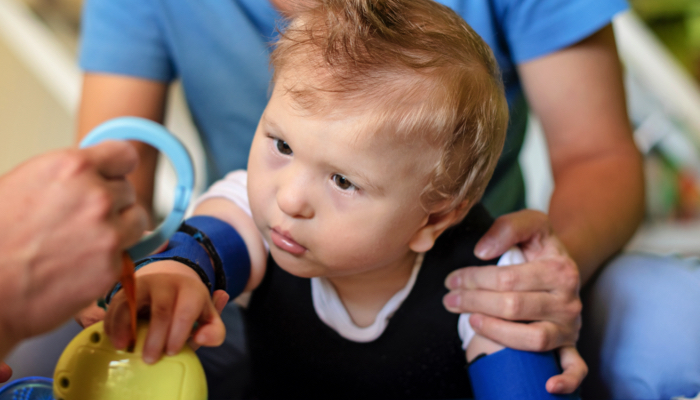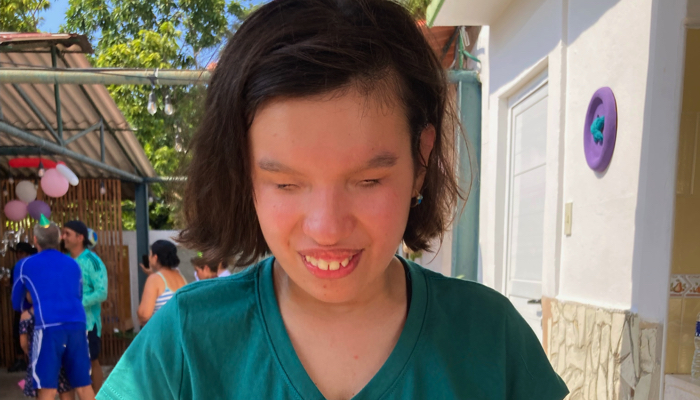Leber’s Congenital Amaurosis (LCA) FAQ

Maybe you’ve just realized that your infant is blind and you’ve come across the acronym LCA in your research, or maybe your child has been given a diagnosis of LCA (Leber’s Congenital Amaurosis) from your doctor.
Either way, I’m sure you’re confused and want to know as much as you can about this rare disease. I’ve compiled the most important questions I was asking when I first began learning about LCA—and I’ve done my best to answer them as completely as possible.
I hope these questions and answers will help you begin to understand LCA and move on from diagnosing and treating your child to simply loving and caring for them! If you have any more questions to add to this list (or if you have a better answer than I’ve posted here) please contact us.
Questions:
- What is LCA?
- What causes LCA?
- What if we have no history of eye disorders in our family?
- How do I know if my child has LCA?
- What are the symptoms of LCA?
- Are there any other long-term symptoms beyond vision loss?
- What can my child see?
- Is LCA degenerative?
- What tests should my doctors run?
- Will my next child have LCA?
- Is there a cure?
- What is the ongoing care for the disease?
What is LCA?
Leber’s Congenital Amaurosis (LCA) is a rare genetic disorder in which retinal dysfunction causes vision loss, often from birth. The extent of vision loss varies from patient to patient, but can be quite severe (with little to no light perception).
LCA is named after the doctor who first described it, Dr. Theodore Leber (Dr. Leber also first described Leber’s Optic Neuropathy, a disease of the optic nerve, which is medically unrelated to LCA). Congenital means “a condition existing since birth, usually hereditary,” and Amaurosis refers to a total loss of vision, especially when the vision loss does not result in any apparent change to the eye. This is why LCA eyes usually look normal upon initial examination.
What causes LCA?
LCA is an autosomal recessive disease. This means that both parents must be carriers of the defective gene that causes LCA. Carriers bear the defective gene but are not necessarily afflicted with the disease.
In the table below, each parent has one red defective gene (A) paired with one black non-defective gene (B). This means that the parents themselves are carriers but do not have LCA. Through four possible scenarios, each parent contributes one gene to the child, either a red or a black. As you can see, this means that the child has a 25% chance of having the disease (receiving two red genes), 50% chance of being a carrier (receiving one red and one black), and a 25% chance of being neither (receiving two black genes).
| Autosomal Recessive Inheritance Patterns |
|---|
| 1 | 2 | 3 | 4 | |
|---|---|---|---|---|
| mother AB -> | A | A | B | B |
| father AB -> | A | B | A | B |
| child | AA (LCA) |
AB (carrier) |
AB (carrier) |
BB (normal) |
Note that in some rare cases (as with the CRX gene) LCA can be dominant. This would mean that the mutation appeared spontaneously in the germ cell of only one parent or during the early development of the child and the chance that their next child will have LCA is very small. However, the child’s chance of having a child with LCA is much higher than usual at 50%.
LCA is primarily a genetic disorder and the most promising research right now involves gene discovery and gene therapy.
What if we have no history of eye disorders in our family?
Because LCA is an autosomal recessive disease, it can lay dormant in a family’s genes for generations. It’s a very rare disease and a carrier of LCA needs to find another carrier in order to have a child with LCA—and even then there’s only a 25% chance the child will have the disease. See the table and question above for more details on how LCA is inherited.
How do I know if my child has LCA?
There are currently two ways to attain a definitive LCA diagnosis. The first traditional way is through an ERG (electroretinogram), which tests the retina’s response to light. ERG’s produce graphs that in normal eyes move up and down, while LCA eyes will produce comparatively flat graphs. This does not, however, mean that the patient has no sight. In fact, the ERG cannot tell you how much your child can or cannot see, it can only diagnose LCA.
The ERG can be a frightening test for young patients. The test involves placing contacts on the child’s eyes that are hooked up to a machine by wires. Young children are often mildly sedated for the exam. There’s some debate about how sedation affects the ERG. Our doctors told us that children must be at least partially awake in order to record accurate results and this is why they don’t use full sedation. Most children remain calm throughout the ERG, but some can become agitated. Because of this, some doctors will use full sedation. Still others don’t use sedation at all. You’ll have to talk to your doctors about this. You can learn more about the ERG by reading our article What’s an ERG?
The second test is a genetic screen of the patient’s blood that looks for the known genetic variations that cause LCA. This test involves nothing more than drawing a blood sample and then waiting… and waiting… and waiting for the results. And, after months and months of waiting, there’s still a possibility you’ll discover that your child’s genetic defect wasn’t found (which may mean they don’t have the disease or may mean that their particular genetic defect has yet to be discovered). If, on the other hand, they do find the defective gene, you now hold some very important information about your child’s disease and can learn more about their type of LCA, not to mention hope that your child’s gene will be a candidate for gene therapy.
Some parents opt out of both tests and choose to diagnose their child based only on symptoms. This is always an option if the genetic test is too expensive (or turned up negative results) and the ERG seems too stressful for your child. Many doctors will provide a tentative diagnosis of LCA if the patient presents most of the common symptoms, even without testing.
What are the symptoms of LCA?
There are many different types of LCA and the disease will present differently in different patients. However, there are some basic symptoms doctors usually look for when diagnosing LCA:
- Severe vision impairment from birth
- Nystagmus (involuntary jerky rhythmic eye movement)
- A normal looking eye upon examination (though there may be some pigmentation on the retina)
- Extreme farsightedness
- Photophobia (sensitivity to light)
- Slow pupillary response to light
- Eye-pressing can be common with babies and children who have very little vision. This can cause damage to the cornea and lens and may result in a loss of fatty tissue around the eye causing the eyes to look deep-set or sunken.
Are there any other long-term symptoms beyond vision loss?
Unfortunately, there is no one answer to this question. Because there are so many different gene defects that cause LCA, there are many different ways the body can be affected by this disease. Many doctors suggest that children with LCA have their kidney function routinely monitored in order to check for errors of metabolism as well Senior-Loken Syndrome.
It’s also been reported that as many as 20% of patients with LCA may have problems with their central nervous system, experience seizures, and may be mentally retarded. In my experience speaking to parents of children with LCA as well as adults with the disease, however, this number seems exceedingly high.
Most patients with LCA seem to have very few long-term symptoms beyond vision loss. Babies with LCA may experience some motor delays, but this is most likely unrelated to the disease itself. Many babies with visual impairment will take longer to learn to roll over, crawl, or walk simply because they do not have normal visual feedback. Working with a physical therapist will help your child’s motor skills, but mostly you’ll just have to be patient—your baby will get there in time. Of course, some visually impaired babies are not delayed at all and develop at the same rate as their sighted peers. Also keep in mind that while moderate motor delays in visually impaired babies is normal, severe delays or worsening motor skills may be a sign of another disorder, often Joubert Syndrome.
What can my child see?
This may seem like the most important question to you right now, but there are two things you need to remember:
- No one can answer this question until your child is much older. No matter the test and no matter the doctor, you won’t really know what your child can see until they’re old enough to tell you. Sometimes you’re absolutely sure they can’t see a thing, then suddenly you notice them blink when you turn on the lights. Your close observation is the best way to determine your child’s visual acuity.
- It’s not as important as you think. As a patient with LCA, your child will most likely be legally blind and a Braille reader. You can’t really know much beyond that until they’re older. And even if you did know, would it really make a difference? Would you love them more or spend more time with them? Of course not! You’re being the best parent you can be right now and knowing how much they can or can’t see won’t change that. Enjoy your child, offer “visual stimulation” through everyday play, but mostly just love them. Rest assured that there’s nothing you can do (or not do) that will damage your child’s sight at this point. They will see or not see what they will see or not see.
Is LCA degenerative?
In most cases, LCA is considered a degenerative disease. However, the extent of that degeneration depends on the type of LCA your child has. For some types of LCA, however, vision (or lack of vision) remains stable.
Also, many parents report that their child’s eyesight seems to improve throughout their first year or two (and sometimes more). I’m not sure that this means that their eyes are physically improving, though. I suspect that the child’s ability to use and understand their vision is what actually improves.
What tests should my doctors run?
Your doctors should of course begin with a thorough eye exam, which should be performed by a pediatric ophthalmologist because young eyes look different than adult eyes. Before you reach a diagnosis of LCA, your doctors may also order an MRI (to check for Joubert Syndrome), an ultrasound of your child’s kidneys (to check for Senior-Loken Syndrome), an X-ray of their hands, and urine and blood work to test for inborn errors of metabolism.
Two tests are used to diagnose LCA: An ERG (electroretinogram) or a genetic screen of your child’s blood. Read How do I know if my child has LCA? for more information on these two tests.
Will my next child have LCA?
Maybe. Many parents opt to have more children after an LCA diagnosis, but you should be aware of the risks. When both parents are carriers, babies have a 25% chance of having LCA. In rare cases where LCA is dominant, there may be a 75% chance. Read What causes LCA? for more.
Is there a cure?
Short answer: Yes.
Long answer: Yes, if you have the right genetic mutation.
Advances in gene therapy are moving unbelievably fast. Many researchers are focusing their efforts on LCA and they’ve already made great strides with the RPE65, GC1, and LRAT genes.
Currently, there is one FDA approved treatment for LCA caused by the RPE65 gene. You can learn more about Luxturna on their website.
What is the ongoing care for the disease?
There really isn’t any ongoing care for LCA. There are some preventative measures you can take, though. As mentioned above, some doctors suggest having your child’s kidney function routinely checked. You may want to take your child to an ophthalmologist annually to monitor their visual acuity and any degenerative vision loss (See Is LCA degenerative?). Also, some forms of LCA are associated with other genetic disorders (the CRB1 mutation, for example, is sometimes associated with Coats Disease) and it’s a good idea to meet routinely with a specialist who can recognize these other disorders (this may mean traveling to visit a doctor who specializes in LCA).
On the other hand, some parents feel that the travel and doctor’s visit is too stressful and too unnecessary to justify. You’ll have to decide what works best for your family.
Of course, you’ll probably want to at least keep up with the advances in gene therapy and other therapies by reading our news blog.
Most realistically, though, your ongoing care is going to involve teaching your child how to live successfully without sight. You’ll want to teach them Braille, help them learn how to get around on their own, and encourage their self-esteem. Even if your child is still an infant, it’s never too early to get started. Contact your state’s Early Intervention Program to find out what resources are available for you and your family.
Thank you to everyone on the LCA list for looking over this FAQ and helping me gather as accurate information as possible! Special thanks to Fran, Sean, Sydney, and Celine for their input.
Read this article in Arabic: قراءة هذا المقال بالعربية
The information WonderBaby provides is not intended to be, and does not constitute, medical or other health advice or diagnosis and should not be used as such. Always consult with a qualified medical professional about your specific circumstances.
Related Posts

Eye Conditions and Syndromes, Support, Visual Impairment
Coping with a Diagnosis: Emotional Support for Families with Visually Impaired Children
Families with emotional support are more resilient. Learn how to establish emotional support with peers, professionals, and the community to help your family thrive.

Special Needs, Visual Impairment
Why Early Intervention Is Critical for Blind Children
Children diagnosed with visual processing disorders, low vision, or blindness need specialized treatment. Early intervention programs can help.

Eye Conditions and Syndromes
Finding Joy and Strength in Raising a Child with Anophthalmia
When raising a child with anophthalmia, be patient, be kind to yourself, and take it one day at a time. Your child will fill your life with love!